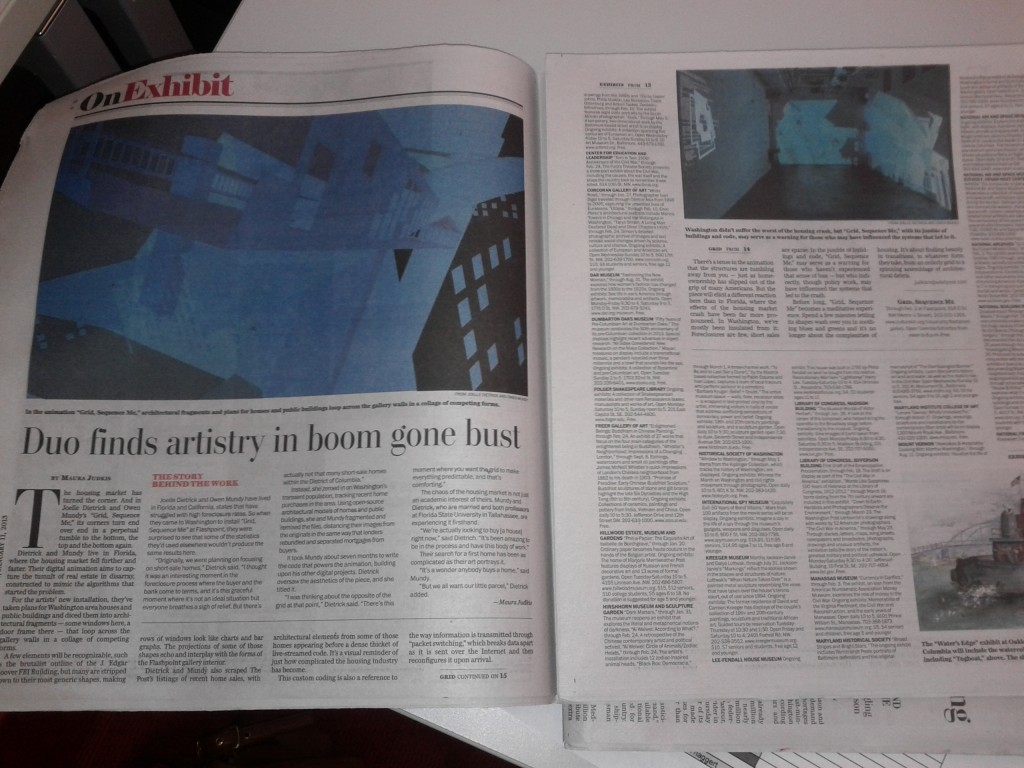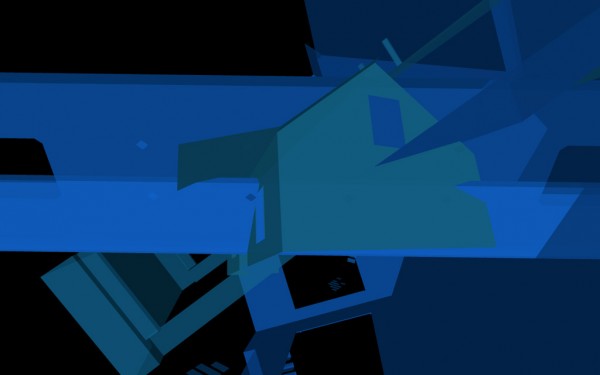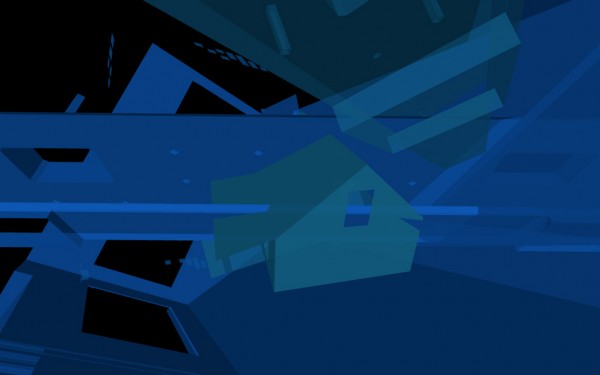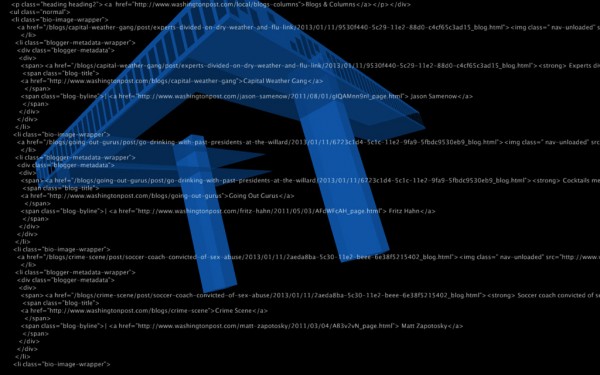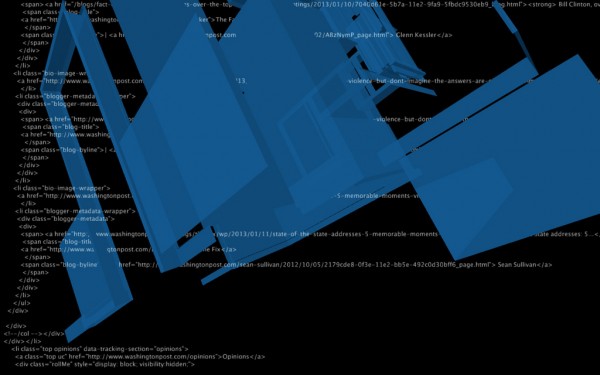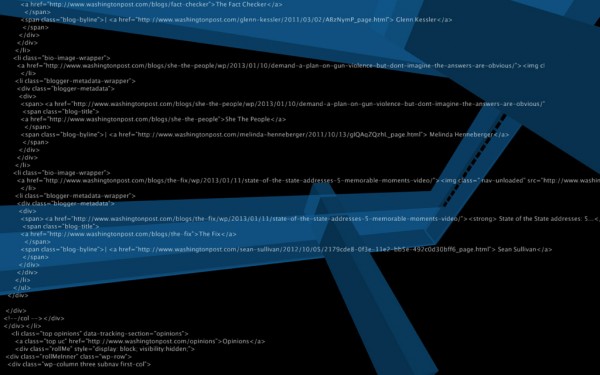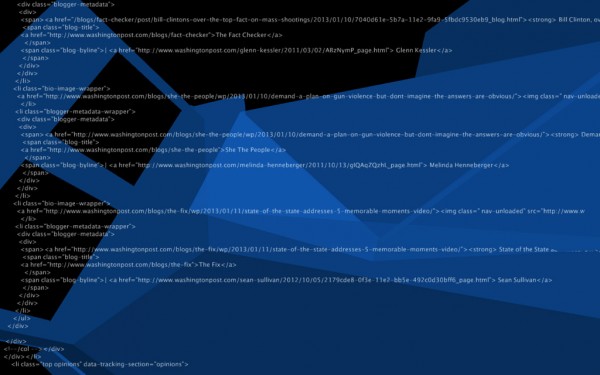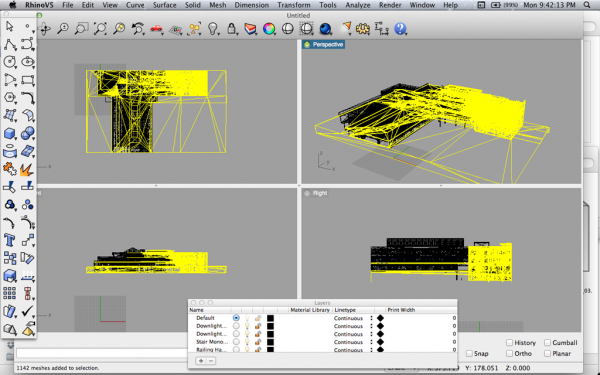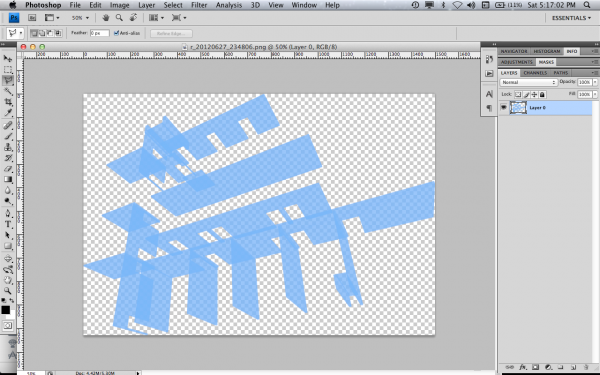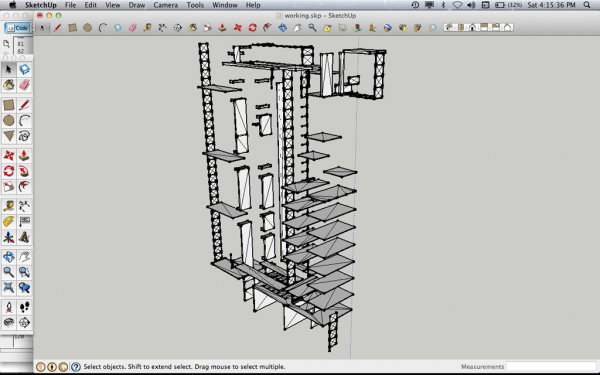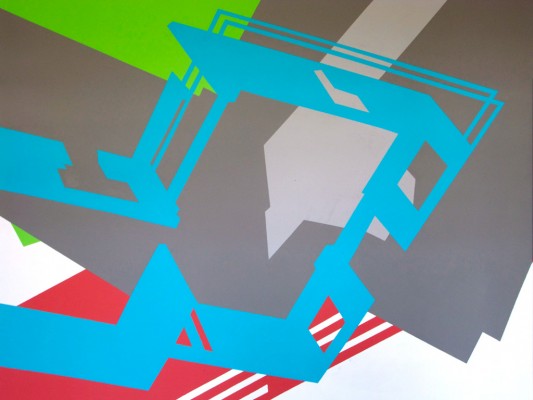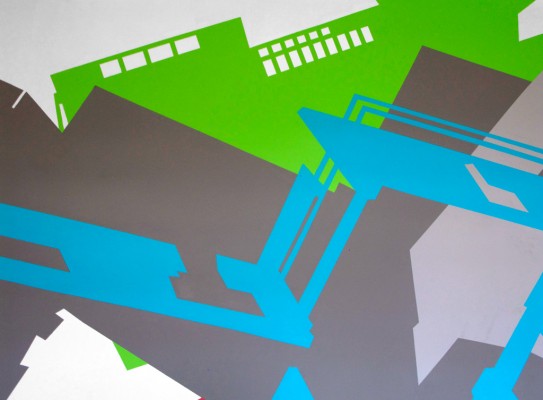In-progress shots from A Network Has No Center (2013) commissioned by Sarah Higgins for the exhibition “Terms & Conditions of Use”, at the Center for Curatorial Studies Bard / Hessel Museum.
Category: exhibitions
Terms & Conditions of Use @ Bard College
Owen Mundy
Deborah Stratman
Brad Troemel & Jon Vingiano
Commodify, Inc.
Curated by Sarah Higgins
Hessel Museum of Art
Annandale-on-Hudson, NY, USA
March 24–May 26, 2013
Exhibition Webpage: CCS Bard
e-flux announcement
Expanding forms of virtual connectivity and networked interaction have given rise to modes of monitoring and control that no longer resemble traditional audio/visual surveillance. Digital interactions, such as social networking or the use of search engines and reference sites, is now contingent on a voyeuristic model of give and take. This reciprocity forces an implicit social contract: the user relinquishes control, not only over their produced content, but over their accumulated history of actions, connections, and behaviors. This is offered in exchange for greater connectivity, social visibility, and an increasingly personalized consumer experience. An industry has rapidly proliferated, driven by advances in information aggregation and predicated on the commodification of the online subject.
Monitoring and control-embedded beneath the architecture of online communities founded on the promise of connectivity-have altered the conditions upon which artists build resistant and critical practices.
Artists working to generate visibility and resistance to this substructure face two primary but limiting positions of refusal: to unplug from networked technologies, or to employ methods evolved from a hacker ethos at the risk of replicating the exploitative operations of the power structure. As an alternative, Terms & Conditions of Use argues for a technologically embedded and ethically effective structural critique. The title references the contractual agreements, implicit and explicit, to which participants in online communities are subject, while pointing to forms of artistic engagement that revise terms and conditions towards resistance.
Owen Mundy is an artist, designer, and programmer who investigates public space and its relationship to data. His artwork highlights inconspicuous trends and offers tools to make hackers out of everyday users. He has an MFA in Visual Art from the University of California, San Diego and is an Assistant Professor of Art at Florida State University.
A Network Has No Center, commissioned for this exhibition, addresses a tension between embodied agency and the illusion of agential action within digital space. Control in interactivity is externalized and formally abstracted. The images on Mylar: a special effects explosion from the making of the film Top Gun, and the gridded substructure and geopositioning icon of the Google Maps application point to where site, politics, and representation intersect with digital technologies.
Deborah Stratman is a Chicago-based artist and filmmaker interested in landscapes and systems. Much of her work points to the relationships between physical environments and the very human struggles for power and control that are played out on the land. Stratman works in multiple mediums, including sculpture, photography, drawing and audio. She has exhibited internationally at venues including the Whitney Biennial, MoMA NY, the Pompidou, Hammer Museum, Witte de With, Walker Art Center, Yerba Buena Center, and has done site-specific projects with the Center for Land Use Interpretation, Temporary Services, Mercer Union (Toronto), Blaffer Gallery (Houston), Klondike Institute of Art & Culture (Yukon) and Ballroom Gallery (Marfa). Stratman’s films have been featured at numerous international festivals including Sundance, the Viennale, Full Frame, Ann Arbor, Oberhausen and Rotterdam. She is the recipient of Fulbright and Guggenheim fellowships, a Creative Capital award, and she currently teaches at the University of Illinois at Chicago.
Deborah Stratman’s ongoing work, FEAR consists of publicly distributed business cards soliciting strangers to phone an 800 number that then prompts them to describe their worst fear. The resulting messages are compiled and presented as an audio work, accompanied by a stack of the cards. The decade-long project explores the relationship between real versus imagined cultural fears. The solicitation of fears is neither explained as a work of art, nor is it made clear that the fears may be publicly presented. The work relies on participants’ desires to speak and be heard, even to an anonymous entity with no promise of privacy.
Brad Troemel & Jon Vingiano’s project, Surfcave, is an online image sharing community that allows users to present their browsing habits in realtime. Once the Surfcave Chrome Extension is installed on a device, every image viewed online is fed into the image stream. In order to access the stream, one must first become a member of the community, submitting him/herself to the same conditions of access to personal online behavior that produce the voyeuristic reward. Only by relinquishing online privacy is the user able to access the viewing habits of others.
Commodify, Inc. is an international collective of artists working with digital media platforms. Its members, Birgit Bachler, Walter Langelaar, Owen Mundy, and Tim Schwartz, are responsible for the creation and management of commodify.us. This web based project allows users to access their social media profile data—in this case Facebook—and license that data to intervene in the existing market for their personal information. For Terms & Conditions of Use, the project appears in the form of a series of anonymous visualizations of personal data generated by social media networks. These are printed at the height of the source individual. Accompanying them is a receipt printer connected to a live feed of financial reports: scores that indicate the projected value for each of the personal data packages.
Terms & Conditions of Use is curated by Sarah Higgins as part of the requirements for the Master of Arts degree at the Center for Curatorial Studies.
Terms & Conditions of Use is part of
LESS LIKE AN OBJECT MORE LIKE THE WEATHER
2013 Graduate Thesis Exhibitions
Center for Curatorial Studies, Bard College
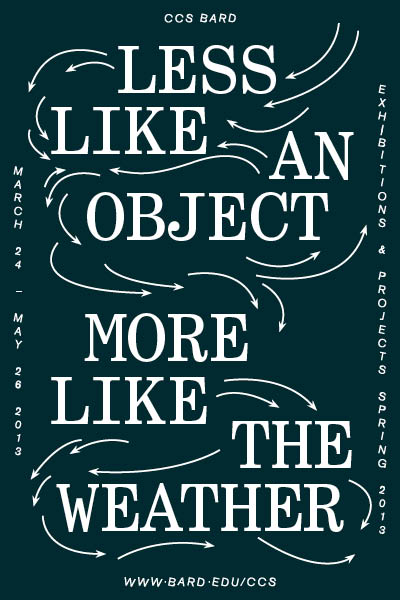
Packet Switcher @ Herron School of Art and Design, IUPUI
 I’m leaving soon to install a new show at the Herron School of Art and Design, Indiana University/Purdue University Indianapolis (IUPUI). The exhibition contains lots of new works, many created in collaboration with other artists and collectives. Ryan Boatright, Joelle Dietrick, The Periscope Project, and Commodify, Inc. (Tim Schwartz, Walter Langelaar, Birgit Bachler). Here’s the PR with details about the show and lecture.
I’m leaving soon to install a new show at the Herron School of Art and Design, Indiana University/Purdue University Indianapolis (IUPUI). The exhibition contains lots of new works, many created in collaboration with other artists and collectives. Ryan Boatright, Joelle Dietrick, The Periscope Project, and Commodify, Inc. (Tim Schwartz, Walter Langelaar, Birgit Bachler). Here’s the PR with details about the show and lecture.
Herron School of Art and Design will host Packet Switcher, an exhibition of recent projects by artist, designer and programmer Owen Mundy. The exhibition opens in the Robert B. Berskhire, Eleanor Prest Reese and Dorit and Gerald Paul Galleries on February 27 with a lecture by Mundy at 6:00 p.m. There will be a reception immediately following from 7:00 p.m. to 9:00 p.m. Packet Switcher runs through April 13.
Mundy is an assistant professor of art at Florida State University. He earned an M.F.A. degree in Visual Art from the University of California, San Diego and a B.F.A. degree from Indiana University, Bloomington. He’s a founder of Your Art Here http://yourarthere.org, an art organization that creates venues where art and ideas can be expressed freely through the use of billboards and other public spaces. In 2009 he created Give Me My Data http://givememydata.com, an online application that helps people get their data out of Facebook in reusable formats.
Packet Switcher contains a survey of recent and never before exhibited works. The individual pieces are varied; from dystopian visualizations of anonymous network data, to custom software which generates print resolution tests from news images. Owing to the increasingly decentralized models of artistic and cultural practice, as well as new forms of authorship like crowdsourcing, this exhibition features numerous collaborative projects with Mundy and other artists including Joelle Dietrick, Ryan Boatright, The Periscope Project, and Commodify, Inc.
The exhibition title references the process used to move digital communication by breaking files into smaller, faster blocks, or packets, of data. The packets travel through networks via the quickest available route and are reassembled at their destination. A digital photograph, for example, might be broken into several packets, each of which may travel through a different city before delivery.
Through a similar process, the artists underscore how incidental fragmentation and automation can streamline markets, but also make them vulnerable to systems failure. The use of architectural images points to recent real estate market volatility and considers how the technology-enabled pursuit of profit alters basic needs.As a U.S. Navy photographer, Mundy observed militarism’s effect on cultures, sites and bodies. These experiences became an important influence on his work.
Also opening on February 27 and continuing through March 19 in the Marsh Gallery will be an exhibition of new works by Herron faculty members Ray Duffey and Marc Jacobson, and in the Basile Gallery, an exhibition of new works by Herron faculty member Stephanie Doty.
Gallery Hours
MON. 10 a.m. – 5 p.m.
TUE. 10 a.m. – 5 p.m.
WED. 10 a.m. – 8 p.m.
THU. 10 a.m. – 5 p.m.
FRI. 10 a.m. – 5 p.m.
SAT. 10 a.m. – 5 p.m.
SUN. ClosedLimited parking is available in the Sports Complex Garage just west of Herron. Park in the visitor side of the garage and bring your ticket to the Herron Galleries for validation. Complimentary parking courtesy of The Great Frame Up. Parking in the surface lot next to Herron School of Art and Design requires a valid IUPUI parking permit at all times.
Rob Bullock
Assistant to the Dean
External Affairs & Development Specialist
Herron School of Art and Design
IUPUI – HR 224
735 West New York Street
Indianapolis, IN 46202
Phone: 317-278-9470
Fax: 317-278-9471
Washington Post review of “Grid, Sequence Me” show + documentation
The Washington Post recently published a review recently about my and Joelle’s exhibition at Flashpoint Gallery in D.C. Check it out: Joelle Dietrick & Owen Mundy: Grid, Sequence Me, by Maura Judkis, Jan 11, 2013.
A few elements will be recognizable, such as the brutalist outline of the J. Edgar Hoover FBI Building, but many are stripped down to their most generic shapes, making rows of windows look like charts and bar graphs. The projections of some of those shapes echo and interplay with the forms of the Flashpoint gallery interior.
Dietrick and Mundy also scraped The Post’s listings of recent home sales, with architectural elements from some of those homes appearing before a dense thicket of live-streamed code. It’s a visual reminder of just how complicated the housing industry has become.
…
There’s a sense in the animation that the structures are tumbling away from you — just as homeownership has slipped out of the grip of many Americans. But the piece will elicit a different reaction here than in Florida, where the effects of the housing market crash have been far more pronounced. In Washington, we’ve mostly been insulated from it: Foreclosures are few, short sales are sparse. In the jumble of buildings and code, “Grid, Sequence Me,” may serve as a warning for those who haven’t experienced that sense of loss — but who indirectly, though policy work, may have influenced the systems that led to the crash.
I also finished a short piece with video from the installation and screen captures of the Processing visualization.
Processing / OpenGL glitches from recent projects
Grid, Sequence Me @ Flashpoint Gallery, Washington D.C.
Surrounded by images of cross-sectioned buildings and source code excerpts, gallery visitors encounter fragments of Washington, DC architecture—a vaguely familiar roofline or grid of office windows—remixed with data and source code representing the latest housing sales in the area. Constantly changing, the live data streams into the gallery from both local sources (DC short sale listings) and national (federal policy sites), emphasizing the effects of related micro-macro shifts.
Generated with custom software, these fragments echo financial systems and housing market fluctuations. They mirror mortgages repackaged and sold, titles lost in administrative tape, and dreams confused by legal jargon. Like the complex financial systems of the housing market heyday, the software generates an infinite number of arrangements. The complexity of unique and dynamically-created algorithmic outcomes contrasts with the comforting predictability referenced in the exhibition’s title, “Grid, Sequence Me.”
—Joelle Dietrick and Owen Mundy
Packet Switching exhibition, Center for Emerging Media @ UCF
CulturalDC Presents: Joelle Dietrick & Owen Mundy: Grid, Sequence Me
CulturalDC Presents
Joelle Dietrick & Owen Mundy: Grid, Sequence Me
Flashpoint Gallery
916 G Street, NW, Washington, DC 20001
01.05.13 – 02.02.13
Opening: 01.05.13, SAT, 6 – 8pm
WASHINGTON, DC – Florida-based art team Joelle Dietrick and Owen Mundy will transform Flashpoint Gallery with an installation of projected animations called Grid, Sequence Me, opening on January 5. Surrounded by images of cross-sectioned buildings and source code excerpts, gallery visitors will encounter fragments of Washington, DC architecture—a vaguely familiar roofline or grid of office windows—remixed with phrases spidered from housing-related websites. Constantly changing, the data will be streamed live into the gallery from both local sources (DC short sale listings) and national (federal policy sites). The inclusion of both local and national data will emphasize the effects of related micro-macro shifts.
Generated by custom software designed by the artists, these fragments will echo the financial systems that led to recent housing market declines. They mirror mortgages repackaged and sold, titles lost in administrative tape, and dreams confused by legal jargon. Like the complex financial systems of the housing market heyday, the software is specifically written to generate an infinite number of arrangements. The complexity of constantly changing outcomes, never repeated, stands in stark contrast to the exhibition’s title, Grid, Sequence Me. We implement grids hoping for comforting, predictable results, even in areas of life—like living arrangements and job creation—that are filled with human folly.
The exhibition offers a space where a visitor can consider how automated, often unseen technological communications and economic systems affect our daily lives and basic human needs.
There will be an artist talk and preview on Saturday, January 5 at 5pm as a part of our membership program. Others are invited to join us. RSVP to gallery@culturaldc.org to attend the artist talk. The public reception will follow immediately after the talk from 6-8pm.
ABOUT THE ARTISTS
Joelle Dietrick’s paintings, drawings and animations explore contemporary nesting instincts and their manipulation by global economic systems. Her recent artworks and research consider housing trends that complicate relationships to place. Her work has been shown at Transitio_MX in Mexico City, TINA B Festival in Prague and Venice, Museum of Contemporary Art (MCA) Chicago, MCA San Diego, Long March Space Beijing, ARC Gallery Chicago, Soho20 New York and MPG Contemporary Boston. She has attended residencies at the Künstlerhaus Salzburg, Anderson Ranch, the Virginia Center for the Creative Arts, Banff Centre for the Arts and the School of the Visual Arts and received fellowships from the University of California, Florida State University and the Deutscher Akademischer Austausch Dienst (DAAD).
Owen Mundy is an artist, designer, and programmer who investigates public space and its relationship to data. His artwork highlights inconspicuous trends and offers tools to make hackers out of everyday users. His work has been shown at Transitio_MX in Mexico City, the California Center for the Arts in Escondido, CA, Compactspace in Los Angeles, Golden Thread Gallery in Belfast, the Sarai Media Lab in New Dehli, Bauer&Ewald Gallery in Berlin and APEXART, Flux Factory and Art Currents Gallery, in New York. He is the recipient of an Individual Artist Fellowship from the State of Indiana, a Planning Grant from Florida State University, a Center for Humanities Fellowship and San Diego Fellowship from University of California, San Diego and a DAAD Arts Study Fellowship. He has an MFA in Visual Art from the University of California, San Diego and is an Assistant Professor of Art at Florida State University.
ABOUT CULTURALDC’S VISUAL ARTS PROGRAM
CulturalDC operates Flashpoint Gallery and produces public art interventions throughout DC. We nurture talented emerging and mid-career artists by providing opportunities for peer learning and mentorship. At Flashpoint Gallery we showcase bold, new work from artists working in a variety of media including site-specific installations, performance pieces, new media and other experimental forms. As a nonprofit gallery free from the constraints of commercial expectations, Flashpoint provides artists and curators a unique opportunity to take creative risks. An advisory panel of noted artists and arts professionals makes programming recommendations for the gallery and provides mentorship and support to exhibiting artists.
Flashpoint Gallery is generously supported by Natalie and Paul Abrams and by DESHO Productions and The Washington Post Company. Hotel Helix is Flashpoint’s 2012-13 Hotel Partner. Marvin is CulturalDC’s 2012-13 Wine Partner.
Funding for CulturalDC is generously provided by The Morris & Gwendolyn Cafritz Foundation, DC Commission on the Arts & Humanities, The Community Foundation for the National Capital Region, The Kresge Foundation, the MARPAT Foundation, the Eugene & Agnes E. Meyer Foundation, the National Endowment for the Arts, Prince Charitable Trusts, The Share Fund of the Community Foundation for the National Capital Region and many other generous partners.
ABOUT FLASHPOINT
Flashpoint is a multi-disciplinary arts space. Flashpoint includes a contemporary art gallery, the 75-seat Mead Theatre Lab, the Coors Dance Studio and shared office space for arts organizations.
Joelle Dietrick & Owen Mundy: Grid, Sequence Me
Opening Reception: Saturday, January 5, 6-8pm
Exhibition: January 5 – February 2, 2013
Gallery Hours: Tuesday – Saturday, 12-6 pm or by appointment
For more information: Call 202.315.1310 or visit culturaldc.org
CulturalDC • 916 G Street, NW • Washington, DC 20001
General: 202.315.1305 Press: 202.315.1310 Fax: 202.315.1303
Email: karyn@culturaldc.org
Packet Switching project: ColladaFragmenter software, Kassel, Germany and University of Florida Public Commission
Joelle Dietrick and I embarked on a new body of work this summer called “Packet Switching.” Inspired by her Sherwin Series images and wall paintings, and my work deconstructing and re-visualizing source code and other data, we’ve created two new software projects, as well as a series of limited edition prints, large photo installations, wall-sized paintings, and animations.
The full statement explains our process and intent clearly:
Packet Switching is an ongoing body of work by Joelle Dietrick and Owen Mundy that visualizes architecture as fragments affected by economic and communications systems.
The title of the series references how contemporary communications systems break digital files into smaller manageable blocks of data called packets. Each packet is then sent through a network, taking the quickest route possible, and reassembled once they reach their destination. One JPG image, for example, might be broken into several packets, each of which may travel a different path through the net, even through different cities, before being recompiled into a copy of the original file.
To reference this common process used in networked systems, we wrote custom software that deconstructs a 3D model’s source code and produces unique fragments. We further remixed these fragments using an original application created in Processing. The resulting images become limited edition prints, large photo installations, wall-sized paintings, and animations.
Our process underscores how incidental fragmentation and automation can streamline markets, but also make them vulnerable to systems failure. The use of architecture specifically points to recent real estate market volatility and considers how communication technology-enabled pursuits of profit margins alters our most basic needs.
The first software, that “deconstructs a 3D model’s source code and produces unique fragments,” is open source and available on Github. Essentially, the PHP software, parses a 3D COLLADA file and exports a set number of geometries, that can then be further broken down and used in an artwork or design.
The second software, which we will release soon, remixes these fragments using Processing. The video below shows an example of the whole process.
Wall painting at “Temporary Home” in Kassel, Germany
While artists-in-residence at Temporary Home, in Kassel, Germany, which coincided with Documenta13, Joelle Dietrick and I completed a wall-sized temporary painting based on the architecture from the Bauhaus School at Dessau and 2012 American color forecasts.
Commission at Weimer Hall at the University of Florida
Joelle and I have also received a commission to complete Packet Switching (Weimer Hall) at the University of Florida College of Journalism and Communications this fall. This will be inkjet on adhesive polyester on a large wall (approx. 177.5 ft. x 20.2 ft.). More details soon.
Drones at Home: Phase 1 – Gallery@Calit2
I’m collaborating with The Periscope Project (TPP) on version 2 of their “Drone Ready-Made: Fine Military Detritus” project in conjunction with the Drones at Home exhibition at Calit2 (see below). In the gallery and online, an interface I programmed, “The Drone War Did Not Take Place,” tracks a Predator drone shipping container, found on Craigslist and retrofitted by The Periscope Project as a camping apparatus, as TPP members guide it through the city of San Diego.
Their path will take them from UC San Diego, past various defense contractors and government agencies including The Space and Naval Warfare Systems Command (SPAWAR), to finally rest at TPP’s downtown location. By (re)mapping data from my Camp La Jolla Military Park project, the tracking interface reveals the connections between the physicality of TPP’s laborious gesture, and the economic and political ties between the object they push and the sites and corporations where everyone employed is implicated in the destructive impact of a permanent arms economy.
The interface will be made public during the upcoming three-day performance by The Periscope Project. It will display their location in real-time, along with images from their journey, and a twitter feed displaying news and unfiltered dialog (hashtag: #dronebox) as they treck through “the largest concentration of military facilities and defense industries in the world.”(1)
1. “San Diego Military Economic Impact Study,” San Diego Regional Chamber of Commerce, January 2007, http://www.sddt.com/files/2007_Military_Economic_Impact_Study.pdf
Drones at Home
March 7–September 14, 2012
Drones at Home explores the strange allure of drones and the push for their domestication —by governments, corporations, and everyday citizens.
Phase 1
Opening Reception March 7, 2012 gallery@calit2, 5pm-7pm
Phase 2
Symposium May 11 & 12, 2012 Calit2 Auditorium, 9am-8pm
Phase 3
Opening Reception June 6, 2012 gallery@calit2, 5pm-7pm
Closing Reception September 14, 2012 gallery@calit2, 5pm-7pm
“Home” is understood at multiple scales-at the level of the individual, backyard, community, border region, and homeland. The San Diego region is featured prominently and regional issues are explored as exemplars of global phenomena. The exhibition also departs from any strict interpretation of the form that a drone must take; the project expands on the “unmanned” nature of the drone as symbolic of a larger condition–ecologies where the status of the human is called into question, distributed and embedded in a wider field of shared intelligence.
Drones at Home will be presented in three phases. Phase 1 includes an exhibition; Phase 2 consists of panels and a workshop; and Phase 3, which continues through the summer, will include the creation of new drone projects in collaboration with invited artists and research groups at Calit2. Co-curated by Sheldon Brown, Jordan Crandall, and Ricardo Dominguez, this first phase will feature the work of Matthew Battles, Trevor Paglen, The Periscope Project, Alex Rivera and Angel Nevarez, along with additional work drawn from research in the field.
Matthew Battles is a poet, writer, and co-founder of HiLobrow.com. His forthcoming books include Letter by Letter (W. W. Norton), a sentimental and natural history of writing, and a short story collection, The Sovereignties of Invention (Red Lemonade). He is a research fellow with metaLAB, an academic and creative collaborative devoted to the exploration of technology in the arts and humanities, hosted by Harvard University’s Berkman Center for Internet and Society.
Alex Rivera is a New York based digital media artist and filmmaker. His first feature film, SLEEP DEALER premiered at Sundance 2008, and won two awards, including the Waldo Salt Screenwriting Award. Rivera is a Sundance Fellow and a Rockefeller Fellow. His work, which addresses concerns of the Latino community through a language of humor, satire, and metaphor, has also been screened at The Berlin International Film Festival, New Directors/New Films, The Guggenheim Museum, PBS, Telluride, and other international venues.
Angel Nevarez is an artist, musician, and DJ. He has produced works which investigate contemporary music, dissent, and public fora, and move between the spatial simultaneity of performance and enunciation, reflecting upon the projection of political agency through transmission and song. His interests lie in the formation of mobile, performative, and discursive-based social spaces, along with the re-articulation of communicatory systems within such locales. Nevarez is also a faculty member of MIT’s Art, Culture, and Technology Program.
Trevor Paglen’s work deliberately blurs lines between science, contemporary art, journalism, and other disciplines to construct unfamiliar, yet meticulously researched ways to see and interpret the world around us. Paglen’s visual work has been exhibited at the Metropolitan Museum of Art, New York; The Tate Modern, London; The Walker Arts Center, Minneapolis; The Andy Warhol Museum, Pittsburgh; Institute for Contemporary Art, Philadelphia; The San Francisco Museum of Modern Art; Massachusetts Museum of Contemporary Art, North Adams; the 2008 Taipei Biennial; the Istanbul Biennial 2009, and numerous other solo and group exhibitions.
The Periscope Project is a space and co-operative based in downtown San Diego committed to the transdisciplinary nexus of art, architecture, and regional urban issues. Operating by the efforts of its resident practitioners; Drone Readymade represents the first discreet project (outside of The Periscope Project itself) undertaken collaboratively. The project’s primary authors are James Enos (M.Arch, NSAD, MFA UCSD, Visiting Assistant Professor, FSU), Molly Enos (M.Arch NSAD, AIA), Charles G. Miller (MFA UCSD), Keith Muller, Andrea Ngan, David Kim, Jon Barth, Jason Durr and Jay Ojeda; with key contributions from Jon Zuppan. For Drones at Home, The Periscope Project is collaborating with Owen Mundy (MFA UCSD, Assistant Professor FSU).
All gallery events are FREE and open to the public.
Please RSVP to Trish Stone, Gallery Coordinator, tstone@ucsd.edu
Media Contact: Tiffany Fox, tfox@ucsd.edu






